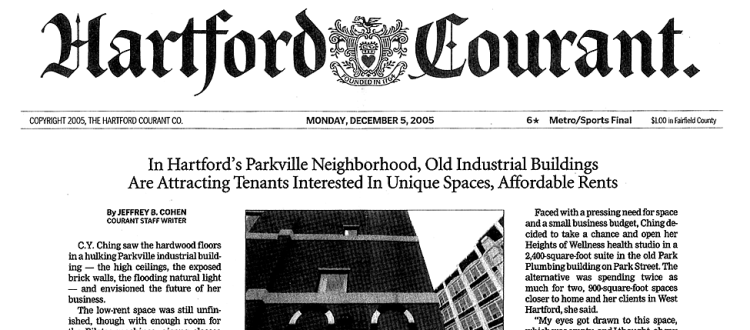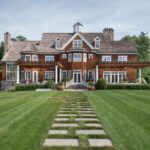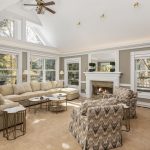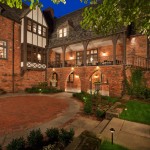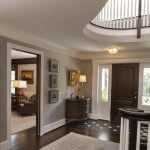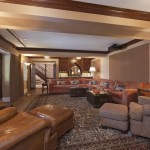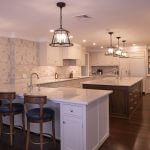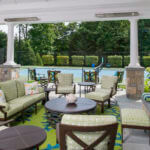The Hartford Courant:
Room for Growth
New Uses Found for Old Industrial Buildings
By Jeffrey B. Cohen
C.Y. Ching saw the hardwood floors in a hulking Parkville industrial building — the high ceilings, the exposed brick walls, the flooding natural light — and envisioned the future of her business.
The low-rent space was still unfinished, though with enough room for the Pilates machines, qigong classes and a massage room, the space had potential. But when she brought some of her clients by to see it, a few were concerned by the building’s location and the neighborhood’s security. Some were scared to cross Prospect Avenue into Hartford.
Faced with a pressing need for space and a small business budget, Ching decided to take a chance and open her Heights of Wellness health studio in a 2,400-square-foot suite in the old Park Plumbing building on Park Street. The alternative was spending twice as much for two, 900-square-foot spaces closer to home and her clients in West Hartford, she said.
“My eyes got drawn to this space, which was empty, and I thought, oh my God, Hartford has such space,” Ching said.
West of the city’s downtown and east of West Hartford, Hartford’s Parkville neighborhood survived even after its factories died. But the neighborhood, once the birthplace of rubber, telephones, typewriters, springs, aerospace parts, bathing suits and more, is now seeing those old spaces redone and refilled.
Parkville never fell on the hardest of hard times that have blighted other parts of the city. Its retail strip of Portuguese bakeries, Asian grocers, small consumer shops and international eateries has kept it a destination even after the thousands of manufacturing jobs left.
Landmarks such as Real Art Ways, Lyman Kitchens and RLF Home have continued to make its industrial hulks a place to go, if not a place to know; other spaces have seen tenants who are looking for lots of space and anonymity.
But now, as downtown Hartford continues to be a big-time work in progress, a few local developers with an eye for a deal and a love for the old buildings that survived urban renewal are trying to raise the neighborhood’s profile.
“I do like old buildings, I like the big boilers,” said William E. Howard, who owns some of the structures that made up the old Hartford Rubber Works. “Aesthetically, they please me. I like them. They’re warm, they’re not sterile, there’s a lot of history behind them.”
In a three-story building that smells of baking bagels, Ching joined another yoga studio, the bagel baker, a pizza chain’s corporate headquarters, a bluejeans company, a lamp maker and an architectural photographer. Once a building in disrepair, the revamped space’s old, glossy-finished hardwood floors and interior walls of glass give renters a sense of lofty chic.
Across the street in the old Barridon building — a huge white box visible from I-84 — stores like a Joe Namnoun oriental rug gallery and an Ann Howard wedding shop will soon join a massive design center that hopes to cater to the luxury home buyers in the city and suburbs.
Two of the neighborhood’s larger landowners are Howard and Carlos Mouta, who have been buying industrial properties in the area since the mid-1990s. Between them, they own at least seven industrial buildings. The old Gray Telephone building on Arbor Street is their most recent purchase — for $1.475 million — and they plan to modernize the H-shaped structure over time, they said.
“It was the only neighborhood left that had any vestige of industrialization that was still intact and that had the possibility of being renovated and looking like Providence or Boston or any of the old mill towns,” Howard said. “I think it’s pride of ownership, being house proud, building proud, in things that are still working after 100 years.”
There has long been much to draw people to this neighborhood, from easy access to the highway, to a strong and diverse small business district, to the unique spaces that the still-standing industrial buildings can provide.
But the most recent wave of multi-million-dollar private investment is tied more directly to the neighborhood’s current economic reality.
“It’s just a matter of timing,” said Mouta, who is also head of the Parkville Business Association. “With West Hartford Center being very expensive and downtown space starting to be very expensive, we have a unique space here.”
The Barridon building’s new anchor is a sprawling, 20,000-square- foot interior design center with 20-foot ceilings made to look small and homey, if that home has a $9,000 bed, a $3,000 chair, and lots of custom furniture, fabrics, trims, and more.
The first floor of a building that once housed an aerospace manufacturer is now DesignSourceCT, a center to service architects and designers tired of trekking back and forth to Boston and New York.
Nancy Zwiener and Richard Ott, who own the business, spent close to three years searching for a place to set up shop. They started with the intersection of I- 91 and 84, looking at the North Meadows, East Hartford, Brainard Road, Airport Road, and more.
After reading that property owners such as Mouta wanted to brand this area as a design-oriented district, theytook a look at Parkville. It meant overcoming some first impressions, they said.
“When we first looked at Parkville, it had a very edgy reputation,” Ott said, remembering his first impression of the neighborhood more than eight years ago. “I can remember Parkville when we first got here … ”
” … And driving right on by,” Zwiener said, finishing his sentence.
Now, Zwiener said she expects more businesses from West Hartford to cross the Prospect Avenue line and come east.
“Because it’s safe, it’s established, there’s a huge anchor here now. And, I think there are going to be perhaps some smaller businesses as well who are going to say, `I don’t need to pay West Hartford rents. I don’t need to pay Avon rents.'”
Neither does Leigh Martin.
“One key to our company is to keep the overhead low,” said Martin, a partner in a Chinese-owned denim designand manufacturing company with offices in Shanghai, New York and Parkville. “In order to make a Hartford office work, you need to be able to make the expense low.”
The company, soon to be renamed Axis, has fabric sewing and washing facilities in China, where they make bluejeans and then sell a line to bigger designers. The firm’s Parkville and New York offices are where they meet clients such as Guess and American Eagle, and show them their wares.
“We were located in West Hartford, and we wanted to do something that was more loft and New York in feeling,” said Martin, a Bristol native. “We didn’t want a typical Hartford County dentist office feel,” he said. “We needed a creative environment.”
For now, Parkville’s walk-around retail will stay largely on Park Street. The tenants in the industrial buildings don’t rely on the general walk-in clients that retail needs. That could change, though, as Mouta and others hope to draw more tenants and residents with money.
Mouta targets next year as the opening date for 56 loft apartments on the Barridon building’s fourth and fifth floors — rentals from 900 to 3,000 square feet. Rents, he said, could be between $800 and $2,500, depending on the market.
But whatever comes to the neighborhood, its major property owners — who, unlike their downtown development counterparts, have overwhelmingly avoided public subsidies — all say they’re here for the long haul.
“Using your own money tends to make you a little more interested,” Howard said. “You’ve got to watch your investment; you’ve got to drive by it every day, you’ve got to know everybody who’s around there.”
Brian Lyman owns Lyman Kitchens and the building it occupies, he said. “This didn’t just happen today or last week or last month; it’s been developing over maybe the last five years,” he said. “There’s been a slow progression.
“But there’s been an expansion of businesses and pride in ownership — not only of the businesses, but of the buildings,” said Lyman, who bought the building in 1998.
Ching held a grand opening for Heights of Wellness in January and is slowly building her base.
“Now they’re more accepting,” she said of clients who live west of Hartford. The parking lot is well-lit, the neighborhood and its Parkville banners are welcoming, and the restaurants are a draw, she said. “Business is picking up.”

